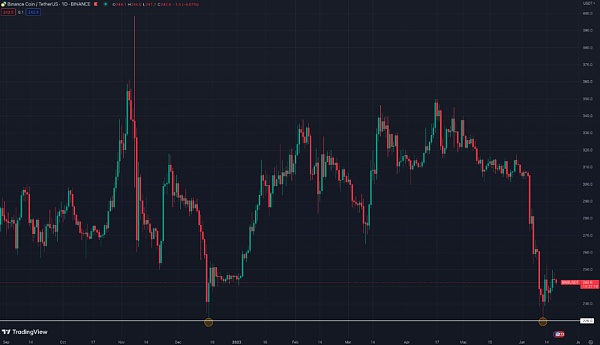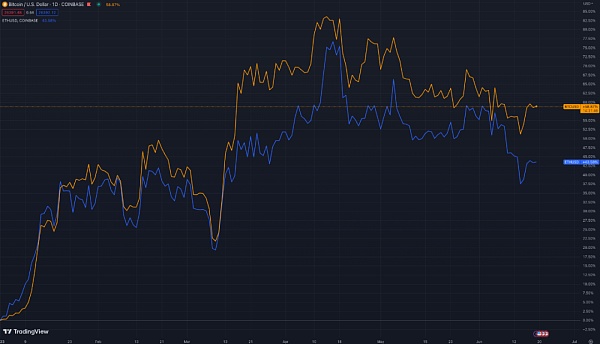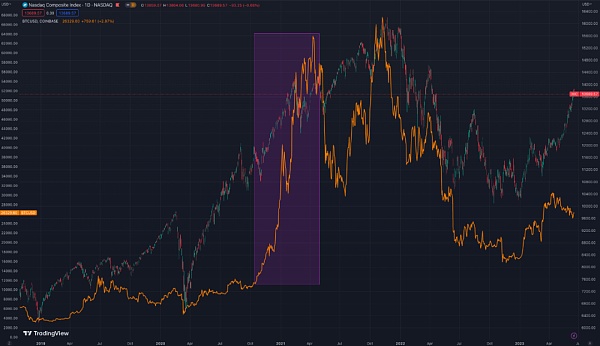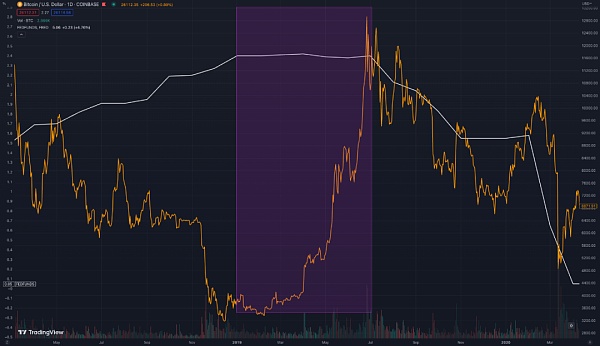Author: 0x1987
Summary
Recently, the US SEC filed a lawsuit against Binance and classified several tokens as securities, triggering the market to sell off altcoins and spreading panic. In our view, the bottom may already be near, with funds from altcoins flowing into BTC and ETH, and the market completing its bottom-building process through fluctuations. Looking ahead to the macro environment in the second half of the year, we analyze three scenarios for US economic development and their impact on the cryptocurrency market. Despite the process not necessarily being smooth, BTC will rise again after experiencing fluctuations.
Short-term fluctuations may continue, but the bottom is near
- Latest overview of the biggest Bitcoin holders
- Binance Research LSDFi Report: When Liquidity Staking Meets DeFi
- Will the BlackRock Bitcoin Spot ETF be approved?
SEC regulatory issues trigger altcoin sell-off, short-term attention on whether BNB stabilizes
The SEC initiated a civil lawsuit against Binance and classified tokens such as ADA, SOL, and MATIC as securities, reigniting concerns about regulation in the market. For compliance reasons, certain institutional investors had to sell off their altcoins, and even the trading platform Robinhood will delist these altcoins, bringing short-term selling pressure to the market.

Tokens such as ADA, SOL, and MATIC that were classified as securities by the SEC have fallen sharply
BNB also fell by more than 20%, with its trend serving as a barometer for the market’s interpretation of the regulatory event. When Binance’s FUD caused a run on withdrawals in December last year, BNB hit a low of $220, then rebounded and stabilized. $220 is an important price level, serving as both a support level for the previous low and the widely watched “liquidation price” of the Venus hacker (in fact, Binance said it has taken over the hacker’s position and there will be no liquidation). This time, BNB retested the low of $220, then quickly rebounded, and Binance also launched a new round of Launchpool to boost BNB prices. If BNB can stabilize and fluctuate for a period of time, it will indicate that the market is gradually digesting the negative impact of the SEC.

BNB found support at the previous low of $220
Altcoins have fallen back to their lows while BTC remains strong, and the bottom may already be near
From a price perspective, many altcoins have fallen back to their lows before the rise in January, and even many have fallen below the lows of November last year. This Binance regulatory event is completely different from last year’s FTX explosion, with no signs that Binance has misappropriated user assets to create a deficit. The worst-case scenario may be that Binance shuts down its US station, so the impact on the market will be smaller than it was at that time. Considering that altcoins have fallen back to their lows before, there is little room for further downside, and we may already be near the bottom.

The total market value of cryptocurrencies excluding BTC and ETH has fallen to the level of last November after the FTX incident. At the same time, BTC and ETH prices are relatively strong, and their gains since the beginning of the year are still around 50%, indicating that large funds still have strong confidence in the market. The funds on the altcoins may not have flowed out of the market, but instead have gathered into BTC and ETH.

BTC and ETH have still gained about 50% since the beginning of the year.
Of course, there is a small possibility that the SEC may increase sanctions on the cryptocurrency industry, but after experiencing a round of decline, the risk has been released, and the space for further decline is limited. In the short term, the market is likely to bottom out through shocks, thereby digesting the negative impact.
Three situations of rising cryptocurrency market in the second half of the year
Looking forward to the second half of the year, the overall macro situation will gradually develop in a favorable direction. The United States is still the country with the greatest influence on the cryptocurrency market in the world. Depending on the US economic situation and the corresponding monetary policy of the Federal Reserve, we may encounter three situations: 1) The US economy is not in recession, and the US stock market enters a bull market, thereby pouring funds into cryptocurrency assets; 2) The US economy is in shallow recession, and the Federal Reserve will start to cut interest rates at the end of the year, and BTC will benefit from loose expectations and rise in advance; 3) The US economy is in deep recession, triggering a liquidity crisis, the Federal Reserve will restart QE, and BTC will experience a rapid rise similar to March this year.
The US economy is not in recession, and the US stock market brings fund inflows
Since this year, US inflation has fallen below expectations, employment data and the performance of large technology companies have also been good, showing that the US economy is very strong. Driven by the AI boom, the Nasdaq index has risen strongly, with a rise of more than 30% from the low point in January, and Apple and Nvidia have reached historic highs. This rise is mainly driven by large technology companies. If the US economy does not decline, the US stock market will continue its trend and enter a comprehensive bull market. In the middle and late stages of the bull market, funds overflowing from the US stock market will enter the cryptocurrency market, pushing up market prices.
Looking back at the previous bull market, during the early stage of the US stock market bull market, the value of cryptocurrencies rose slightly but mostly followed the same trend. It was not until the middle and later stages of the US stock market bull market that funds began to flow out of the stock market and into smaller cryptocurrencies, which experienced the largest and fastest overall increase. Within five months, BTC rose from $10,000 to $60,000. Therefore, if the US economy does not decline and the US stock market enters a new bull market, funds will flow into cryptocurrencies in the middle and later stages of the bull market.

BTC accelerated its rise in the middle and later stages of the US stock market bull market
The US economy is slightly declining, and the Fed’s interest rate cut brings expectations of easing
Due to the Fed’s rapid interest rate hikes, there is a high probability that the US economy will decline, but the degree of decline will not be too severe. In the event of a US economic recession, the Fed will not be able to maintain high interest rates and may start cutting them at the end of the year at the earliest. Lower interest rates mean that the cost of capital is reduced, which is conducive to the flow of funds into risky assets. Furthermore, the Fed’s opening of an easing cycle means that BTC will rise ahead of market expectations for a Fed rate cut.
Looking back at the last rate cut cycle, the Fed’s last rate hike was in January 2019, and it began cutting rates in July of the same year. During this period, benefiting from the market’s expectations of the Fed’s easing, Bitcoin rose from $3,300 in February to $13,000 in June. Therefore, after the Fed stops raising interest rates, the market will anticipate a Fed interest rate cut at some point, and BTC will benefit from easing expectations and experience a wave of growth.

During the period when the Fed stopped raising interest rates in 2019, BTC rose from $3,300 to $13,000. The white line is the effective interest rate of the Federal Funds Rate.
The US economy is in a deep recession, and the Fed restarts QE to rescue the market
Although there is almost no data to suggest that the US economy will experience a “hard landing” at present, we cannot rule out this possibility from a probabilistic perspective. Especially when the market is not fully prepared, once the US economy experiences a deep recession, there is a high probability of a liquidity crisis, and all assets will fall, forcing the Fed to restart QE to rescue the market. Cryptocurrencies will first fall due to liquidity and risk aversion, and then benefit from the liquidity released by QE.
Looking back at the US banking crisis in March of this year, BTC first fell due to market panic and risk aversion, and then the Fed urgently launched liquidity tools to rescue banks, expanding the balance sheet. BTC benefited from the liquidity released by the small QE, soaring from $20,000 to $28,000 in just one week. Therefore, if a liquidity crisis occurs, the Fed is likely to restart QE, and BTC will likely repeat the rapid rise of March.

BTC first fell and then rose when the March banking crisis broke out.
Conclusion
In the short term, BNB quickly rebounded at the key support level of $220, and is expected to stabilize and oscillate, helping the market digest the negative impact of regulatory events. Altcoins have fallen to the low levels of the year, with limited downside potential. Funds are gathering towards BTC and ETH, and the market may complete the bottom-building process through oscillation. Looking forward to the second half of the year, although the macro environment’s uncertainty still exists, BTC has the hope of ushering in a wave of growth no matter how it develops. We are still optimistic about the market’s performance in the second half of the year.
Like what you're reading? Subscribe to our top stories.
We will continue to update Gambling Chain; if you have any questions or suggestions, please contact us!